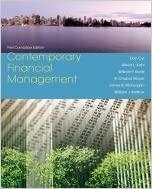Question
An increase in investor risk aversion would be expected to: Increase the Risk-Free Rate while Decreasing the Expected Return on the Market Portfolio. Increase the
An increase in investor risk aversion would be expected to:
Increase the Risk-Free Rate while Decreasing the Expected Return on the Market Portfolio.
Increase the Risk-Free Rate while Increasing the Expected Return on the Market Portfolio.
Decrease the Risk-Free Rate while Decreasing the Expected Return on the Market Portfolio.
Decrease the Risk-Free Rate while Increasing the Expected Return on the Market Portfolio.
There is not enough information to determine how the Risk-Free Rate and Expected Return on the Market Portfolio will change.
None of the above answers is correct.
Step by Step Solution
There are 3 Steps involved in it
Step: 1

Get Instant Access to Expert-Tailored Solutions
See step-by-step solutions with expert insights and AI powered tools for academic success
Step: 2

Step: 3

Ace Your Homework with AI
Get the answers you need in no time with our AI-driven, step-by-step assistance
Get Started


